Here are some coarse fishing reports outstanding from the end of February. On the 23rd Kevin Tompkins from Bath fished with two friends at Middle Hill Court. This was a day of heavy rain and a great western gale which came roaring up our valleys. I was shooting in the same wind that day; once launched the clays were zig-zagging all over the sky and I was afraid to open the tailgate of the car lest a gust should tear it off. Still it was quite warm and despite Kevin describing the weather as “atrocious for humans,” his party caught a chub and 7 Wye barbel to 11 pounds 14 ounces. AH from Whitney had 4 chub at Middle Hill Court while CM from Keynsham recorded a pair of barbel at 3 and 5 pounds. Keeper Stefan used his tractor to pull this angler’s car out of a flooded access track, the problem having been relayed to the beat owners by Allyson at the Foundation. I suppose that would not have been possible on a weekend. In fact I drove this track later when the salmon season had opened and it does badly need some fixing at one particular point where it has been damaged by heavy farm vehicles crossing. Meanwhile SC from Hull had 2 barbel and 3 chub at Middle Ballingham and Fownhope no 8.
The weather changed now, to days of high pressure with sharp morning frosts followed by big swings in temperature as the rising sun began to warm the landscape. While the water was still high and showing a tinge of colour, Peter Thomas from Kidderminster caught 11 grayling from the Lugg at Eyton. He also caught 20 out of season trout, which boded well for the coming season. Many anglers were struggling on the main river during the cold, bright mornings and many blanks were recorded. Paul Morton from Yeovil with a friend had 8 chub at the Creel. However, a party led by Alan Godfrey from Hoddesdon had 25 chub from the Creel and 6 chub and 2 barbel from Middle Hill Court. The following day the group recorded 38 chub from the Creel, 8 chub from Middle Hill Court and 4 more chub from How Caple Court. A third day for this group, this time divided between Middle Hill Court and the Creel produced a remarkable 8 barbel and 80 chub. A final effort by the same group on the same beats produced 14 barbel and 17 chub.
 Courtfield - Jonathon Kitching
Courtfield - Jonathon Kitching 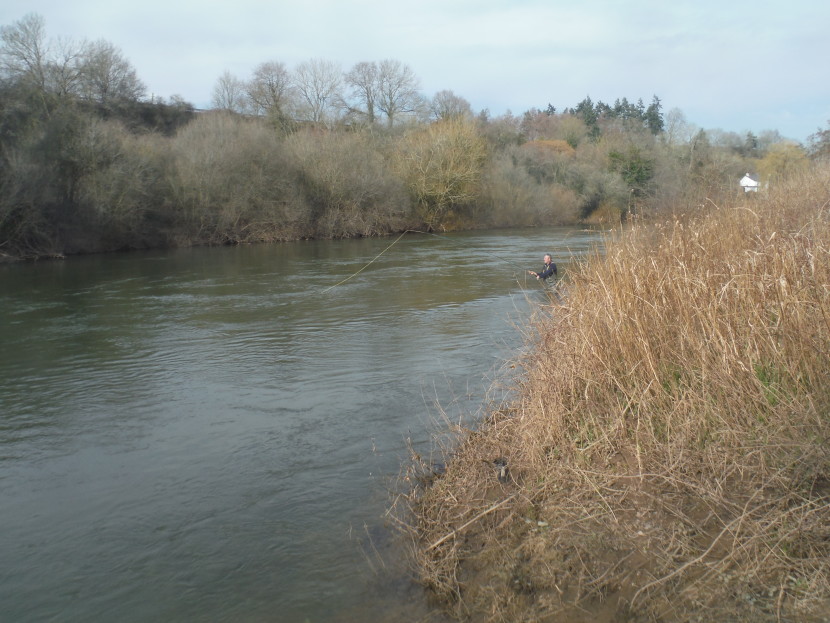 Goodrich Court
Goodrich Court The new trout season opened on the 3rd March and most fly fishers headed for the Usk, which is usually the earlier of the two rivers. The weather was still very cold and bright and again most of us struggled, sometimes without sign of either fly or rising fish. I made a particular note of this report from SB of Stoke Lacy who fished with a friend at Penpont on opening day: “Water very fishable but very cold (no higher than 6 degrees on the thermometer all day). Plenty of spider and nymph fishing with no success and no fish seen. About to leave when spotted a fish rising regularly 100 yards above the bridge. So put a size 16 Olive Quill over it and landed it first cast.”
Clearly that was a memorable fish and well earned. Alwyn Thomas with a friend was at Dinas on the 4th: “Water temperature again was very cold. Some nice hatches of LDOs here and there and the only rises we saw were far off. Neither of us covered a rising fish all day, which must be a first.”
RG from Freshford fished at Fenni Fach just above Brecon and mentioned seeing olives and the occasional March brown, but nothing was rising to the hatches. Eventually he caught a lean 15 inch trout on a nymph. Meanwhile on the lower Wye at Middle Hill Court, William Morris from Stroud was surprised to catch 5 grayling along with a couple of chub: "Didn’t know they were there…one of the chub was an old warrior too, so all in all a good day.”
Benjamin Wheatley from Stratford had a mixed bag of 6 trout and 6 grayling from the Lugg at Lyepole. Ceri Thomas from Cardiff fished the Honddu tributary of the Usk and recorded 10 trout on nymphs. By the 7th with water levels still dropping steadily, JS from Reading with a friend were able to fish the lower Wye at Wyebank, where they caught a barbel of 6 pounds and 6 chub to 5 pounds 5 ounces.
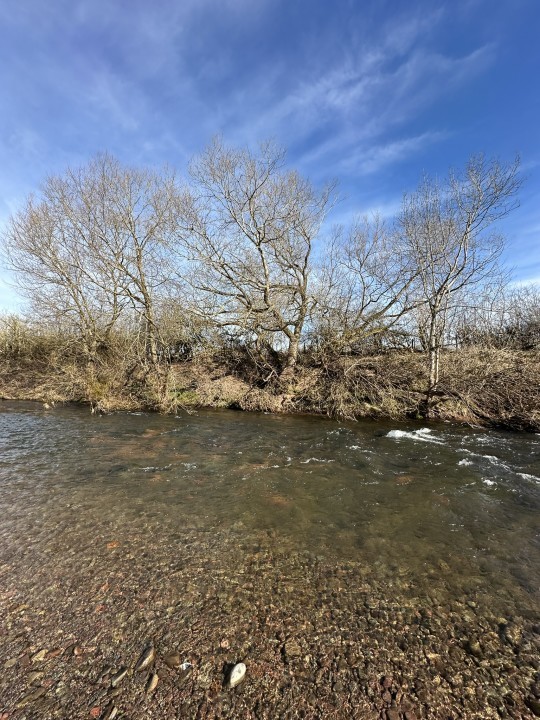 Dinas - AC from Shroud
Dinas - AC from Shroud  - Ceri Thomas from Cardiff.jpg?w=830) Honddu (Usk) - Ceri Thomas from Cardiff
Honddu (Usk) - Ceri Thomas from Cardiff The weather warmed further and on the 9th Seth Johnson-Marshall of Afonydd Cymru had the sort of spring session on the middle Usk we all dream of. Everything happened between 11.30 and 2.30, but in that period large dark olives were hatching and for a brief 15 minutes some March browns were emerging. Using a March brown dry imitation, Seth took a memorable leash of trout measuring 19.5, 18.5 and 12 inches. That day Martin Mcmaster from Coleraine was on the Breconshire Fishery and although he caught his 5 trout on nymphs he noticed trout rising to March browns. This was a very pleasant weekend everywhere; Andrew Gardner from Taunton was fishing the Wye at Middle Hill Court, “…a lovely day in the sun,” where he measured the water temperature now up to 9.8 degrees. Using stick floats as well as feeders he caught 5 barbel and 17 chub. Martin Keighly from Boston was on the same beat and caught 7 barbel to 8 pounds 10 ounces and 6 chub.
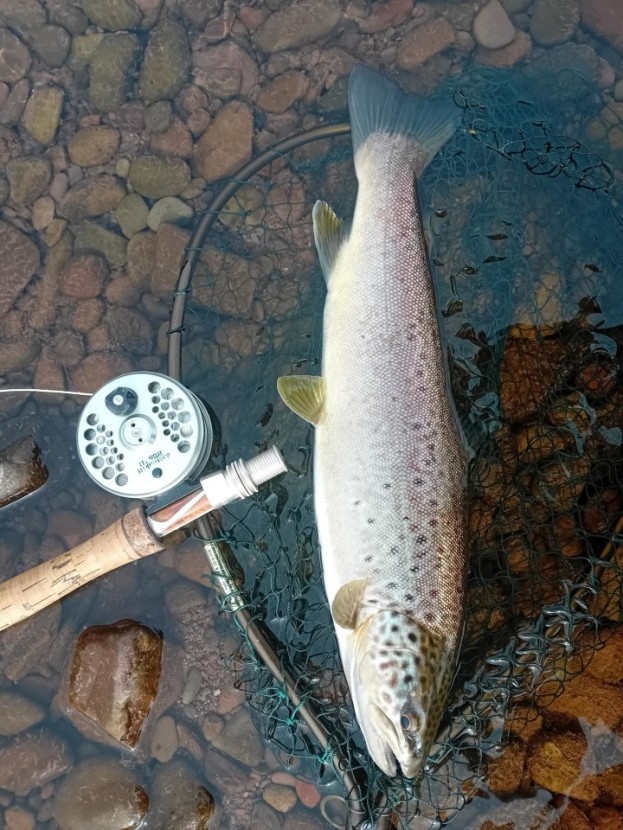 March brown feeder 1
March brown feeder 1 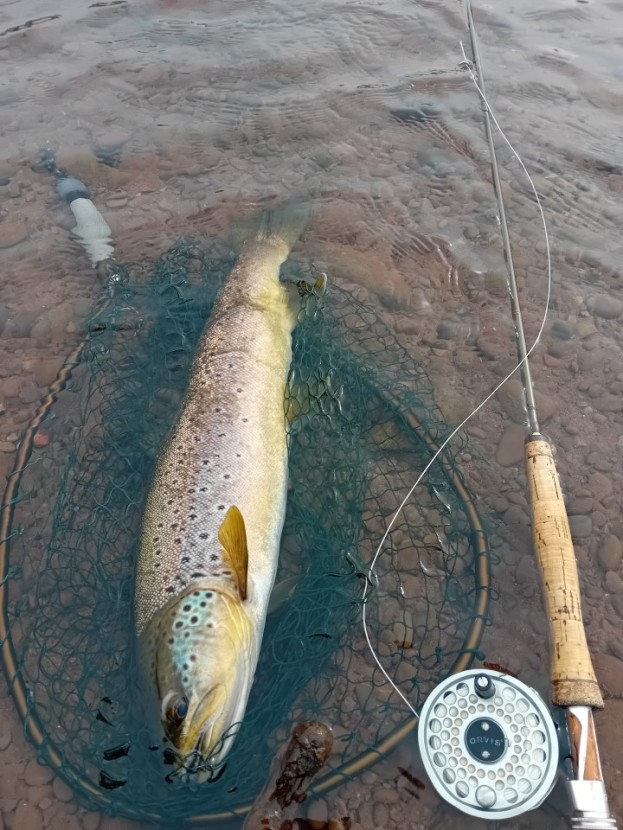 March brown feeder 2
March brown feeder 2 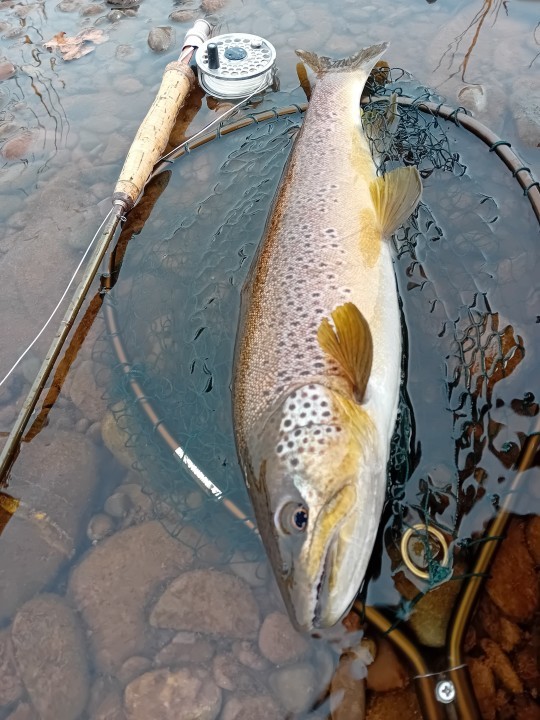 March brown feeder 3 - Seth Johnson-Marshall
March brown feeder 3 - Seth Johnson-Marshall  Usk Town Water - JG from Bristol
Usk Town Water - JG from Bristol A couple of days into the season now and there was no word yet of Wye salmon caught although fish were reported seen at Whitney Court’s Locksters Pool. Then the much awaited news came rather breathlessly on the 6th March: “What a fight, jumping and stripping line.” This from regular salmon angler Ricky Reno, who had just caught a 34 inch salmon while spinning a red Flying C at Garnons above Hereford. This fish was the first springer to kick off the Wye season. On the 8th the Wyesham beat below Monmouth reported another good fish of 18.5 pounds, also taken with a Flying C.
The brief spell of good weather didn’t last very long and in fact we had some snow on the morning of the 12th. We seemed to be facing a situation in which the water on both Usk and Wye had not really warmed up enough for fly fishing, and yet at the same time the chub and barbel on the main Wye were feeding hard. JG from Bristol with his wife came to fish the Usk Town Water in a sunny spell and caught a brace of trout, one on the dry fly and one on the nymph. A few years ago I often used to fish the two miles of the Town Water and I have some very happy memories of the whole stretch including the shallows and Bridge Pool right in the middle of town. Those were the days when you popped the money for the ticket in an envelope and put it beneath the door of Sweet’s Tackle Shop and off you went for early fishing. Sweet’s is sadly no more, but now you can get a day ticket from the WUF for a very reasonable 15 pounds. Dave Collins from West Herefordshire tried a midday session on the upper Wye above Doldowlod, but found the water very cold although spring olives and March browns were in evidence. He had no trout but 3 grayling, one a good fish of 17 inches which he found rising to midges. PB from Stockbridge reported 6 trout from the upper Usk at Abercynrig.
Meanwhile some of the coarse fishers were really filling their boots as their season on the Wye approached its end. Grant Lloyd from Dinas Powys with a friend had 6 barbel to 8 pounds and 30 chub from the Creel. The same team caught 3 barbel and 19 chub from Holme Lacy 3 and Lechmere’s Ley the following day. Chris Monk from Ware with a friend recorded 3 barbel to 8 pounds and 21 chub to 4 pounds 14 ounces from the Creel, followed by 2 barbel to 7 pounds and 20 chub to 5 pounds from Lower Canon Bridge: “A great day” indeed. Peter Thomas from Kidderminster fished at Holme Lacy 3 and Lechmere’s Ley on a sunny day with a light breeze and caught 4 barbel, 7 trout, and lost count of the chub. Stephen Durber from Alcester used float tackle to take 33 chub to 5 pounds 10 ounces at the Creel. That would be the end of his season. Robert Evans from Cwmbran caught 3 barbel and 10 chub fishing all day at Middle Ballingham and Fownhope no 8 and claimed that he actually manged to get sun-burned! Martin Keighly of Boston recorded 7 barbel to 8 pounds 10 ounces plus 6 chub from Middle Hill Court and then 2 more barbel and 4 more chub from Holme Lacy 3 and Lechmere’s Ley. PS from Stroud caught 14 chub and 1 grayling from the Creel. Mick Newry from Stratford on Avon with a friend reported a large catch of chub of all sizes from Middle Ballingham and Fownhope no 8. Wayne Buckingham from Bathpool Taunton with a companion caught 3 barbel to 7 pounds 10 ounces and 2 chub to 4 pounds 4 ounces from Middle Hill Court, followed by 5 more barbel and 3 chub from Courtfield. Colin Mcsherry from Keynsham with a friend also fished at Middle Hill Court and reported 9 barbel to 8 pounds 12 ounces and 6 chub. The water temperature at the time was recorded at 9.6 degrees. Colin led a group of 4 on the same beat the following day, but had the impression that heavy angling pressure was starting to have an effect. The tally this time was 1 barbel, 1 grayling and 25 chub. Meanwhile David Oliver from Waterlooville with two friends recorded 1 barbel and 12 chub from Middle Ballingham and Fownhope No 8. The weather had become rather persistently cold again, even for an English March, with the wind in the north-east and the water temperature dropping. “A good way to end the river season,” wrote Andrew Hill from Witney about a day on How Caple Court. He had taken 7 chub to 5 pounds 3 ounces and, as the light faded, a barbel of 6 pounds 4 ounces. Jonathon Kitching from Peterborough recorded 2 barbel to 6 pounds 12 ounces and a brace of chub to 5 pounds 6 ounces from Courtfield under the Forest of Dean, but felt he had been crowded by another angler moving in too close. JD from Marlow led a group of five fishing at Middle Hill Court which caught a single barbel and 54 chub. The barbel weighed an impressive 12 pounds 3 ounces.
 Middle Hill Court - JD from Marlow
Middle Hill Court - JD from Marlow 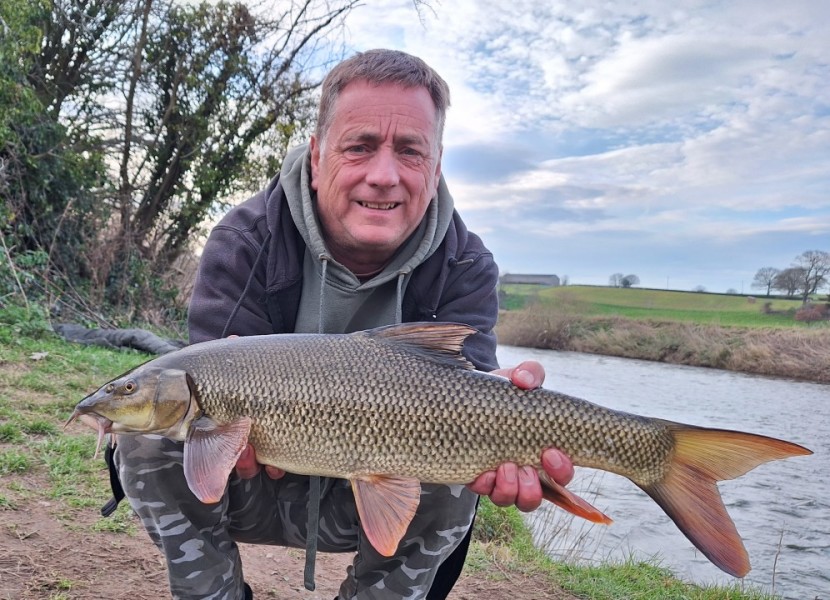 Foy Bridge - Kevin Tomkins from Bath
Foy Bridge - Kevin Tomkins from Bath Sadly an angler from Chilworth near Guildford had complaints to make about fly tipping on the layby designated as parking for Abernant on the upper Wye. This problem has occurred before and it has been suggested by the owner that anglers make themselves responsible for cleaning the public layby. It strikes me that it would be better still if a secure parking place off the public road could be provided for anglers renting this popular beat. We used to park in the entrance to the track behind the gate, although I appreciate there may be a need at times for the farmer to use the same access. And finally Louis Kingwill fishing at Abercynrig on the Usk found himself confronted by a sheep which had got itself stuck in tree roots under the steep bank. I wish I had a pound for every sheep I have had to disentangle there. They are not the brightest of creatures.
On the 13th a visitor from Lyme Regis with advice from gillie Mick Sutton fished hard all day for salmon with the fly at Goodrich Court until finally on the inside of the Corner Tree bend he was bitten off by a pike. There are some big ones in that part of the river where the water is slow and I can well remember watching a 4 foot monster following just 6 inches behind my Flying C in that very place. No, she didn’t take at the end of it all, but turned away. I also remember a conversation with an angler who had been spinning and wading who had the experience of a pike charging at his incoming lure so fast it actually rammed him in the midriff. Much rather you than me, I was thinking to myself.
Michael Stanley from Banbury had 8 large chub and a small grayling from the Creel, while Adam Whitby with a friend from Hungerford reported 12 chub, a grayling and a trout from Whitney Court. Huw Evans from Swansea fished Goodrich Court for salmon on the 14th and reported a poacher seen on the lower part of the beat. I don’t think any challenge was made at the time although a landing net was found on the bank. Andrew Gardner from Taunton led a party of 5 at Middle Hill Court and reported 1 barbel and 18 chub. Jonathan Kitching fished again at the Creel and took 18 chub to 4 pounds 15 ounces. The 14th March spelled the end of the coarse fishing, which has been truly excellent on the Wye this past season. Numbers and quality of barbel and chub from the Wye seem to get better and better year by year. Not so the grayling fishing, which was rather disappointing this winter except for a few good days experienced on the Herefordshire tributaries.
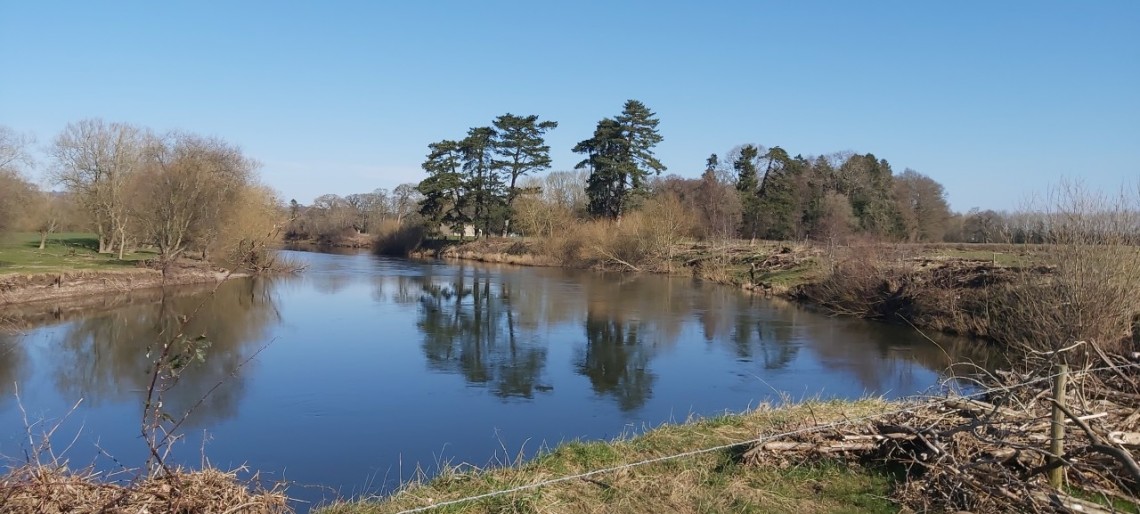 Whitney Court pike fishing - JG from Craven Arms
Whitney Court pike fishing - JG from Craven Arms GD from Gelli fished Llwyn On reservoir in the Beacons on the 15th and informed us: “Waste of money for the beginning of the season – not stocked.” That useful information will have been interesting to the other six anglers who fished Llwyn On that day, and who despite the cold reported 15 trout between them. I always say it’s impressively skilful to catch fish which aren’t biting in difficult conditions, but more skilful still to catch fish which aren’t even there.
On the 18th Owen Watkins and a friend from Pontypool caught their limit bag of 8 fish at Llwyn On. Philip Barber from Swansea caught 4 trout from the Usk reservoir and saw the bailiffs twice during his day, but took the opportunity to advise that they should make random checks more often. AA from Norwich used a small nymph to catch 4 trout including a good one from the Hergest beat of the Edw tributary and rightly considered this quite a good result in the conditions. All over the region the temperatures were very low again with a steady flow of cold air from the north and east leading to morning frosts and grey skies. The Usk valley even experienced some snow. Most anglers saw a few flies on the water by midday, but very few or no fish rising. Steffan Williams from London did better on the Usk at Abercynrig, catching 8 trout on wet flies in the 12 o’clock to 2 o’clock period as March browns were hatching. Stuart Bourne from Llanigon blanked at Doldowlod on the Wye, but pointed out that there is a broken down green van partly blocking the designated angler’s parking by the sawmill and also that the entrance gate to the field is literally in a ropy condition. I think the owners should be able to rectify these problems and there must surely be somewhere available for anglers to park in what is after all quite an extensive yard.
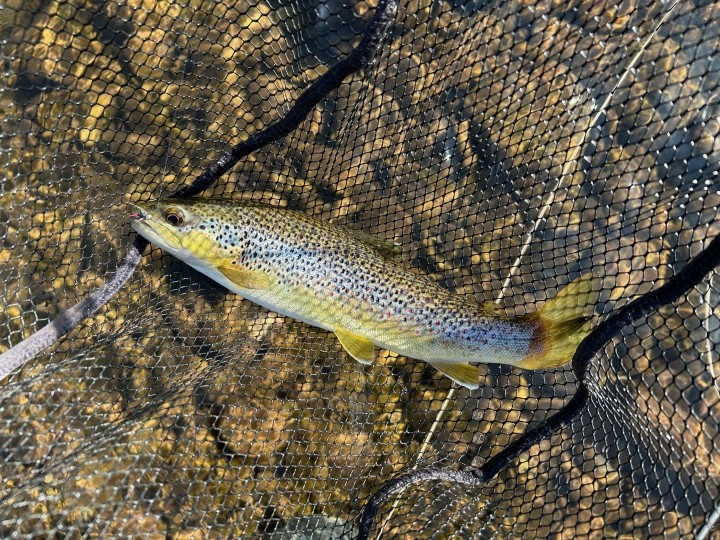 Abercynrig - Roy Pettifer from Didcot
Abercynrig - Roy Pettifer from Didcot 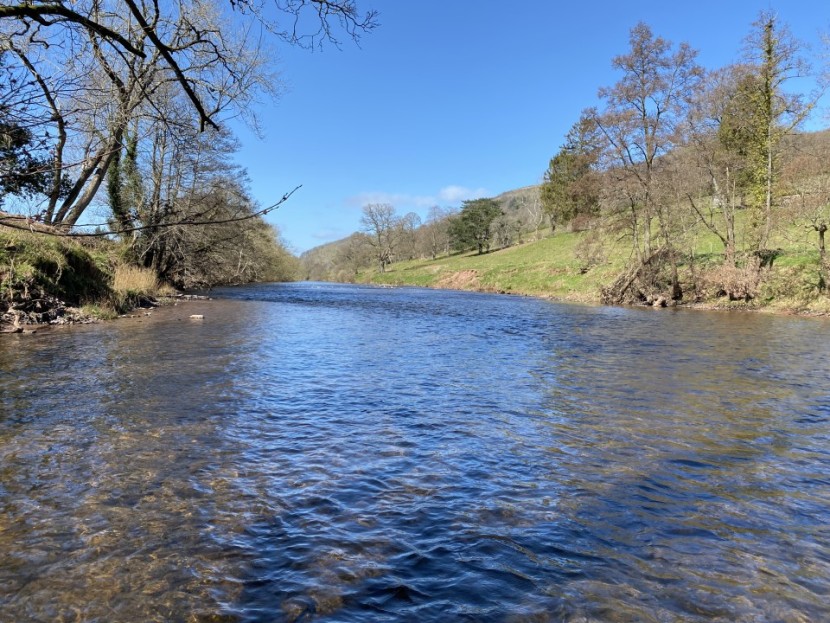 Ashford House - FR from Hereford
Ashford House - FR from Hereford A couple of good reports came from the Usk Town Water on the 18th. AS from Malmesbury had just a brace during a March brown hatch, but they were fine trout of 16 and 18 inches. GM from Shrewsbury caught 15 on the same day fishing dry with a Jingler. As you might expect, the action was between 11 and 2. He fished upstream at Dinas the next day and reported 20 more trout on the Jingler again, fishing it on a long tapered leader in the fast water during the middle of the day. The first Usk salmon came also on the 18th: a fresh 3 sea winter fish taken by Simon Powell from the ISCA water at the bottom end. A Wye salmon was reportedly lost by an Aberdeen angler who had been fishing a Willie Gunn in the Vanstone at Goodrich Court. Rather curiously an angler on the same beat reported an accidental brook trout – I can’t imagine where that came from. Tim Edmunds from Bristol was salmon fishing at Dan y Parc on the Usk and reported a nice accidental brown trout of 2.5 pounds. AA from Norwich, who had previously fished the upper Wye’s Edw tributary, also fished the Usk at Dufnant and while dry fly apparently did not work out he took a very acceptable brace of trout weighing 2.5 and 3.5 pounds on a single nymph.
By the 20th it was definitely warmer and the Usk valley saw afternoon air temperatures in the high teens. Anglers on most beats got to see hatching fly and even occasional rising fish. David Burren and I were at Brecon and we saw a few olives and March browns, but very few rising fish. For some reason, probably laziness, we had both opted not to carry a spare rod made up for spiders and we paid for that decision with a blank. All these days of March had been without rain and the Usk was now as low as I can remember seeing it so early in the year. Philip Bullock with a friend from Churcham spent the day at Penpont and finally got just one 15 inch trout from fast water on a Jingler at the end of the day. Roy Humphris from Bath and his dog enjoyed themselves at Abbeydore, catching only one trout, but “…went home tired but happy.” Nick Fenton did better, catching 13 wild trout up at the Beacons reservoir.
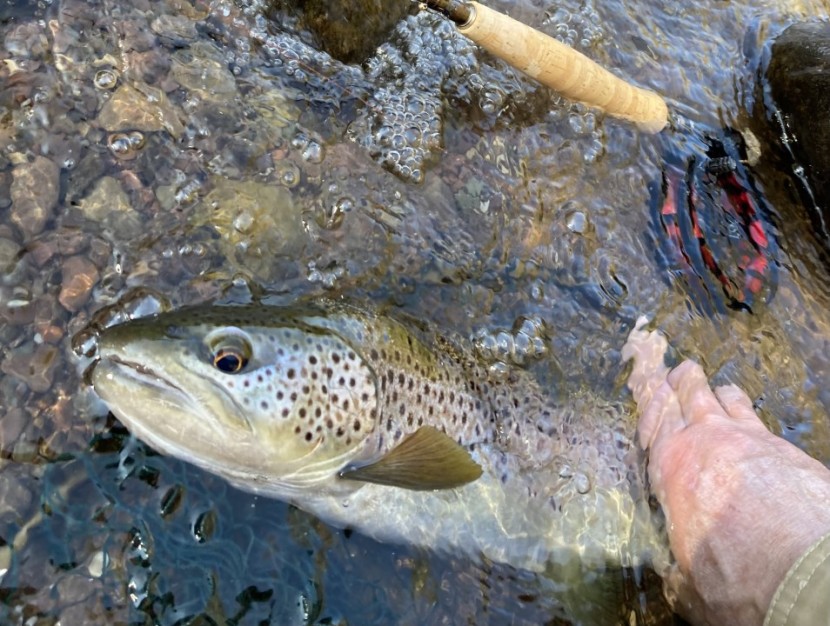 Dufnant - AA from Norwich
Dufnant - AA from Norwich 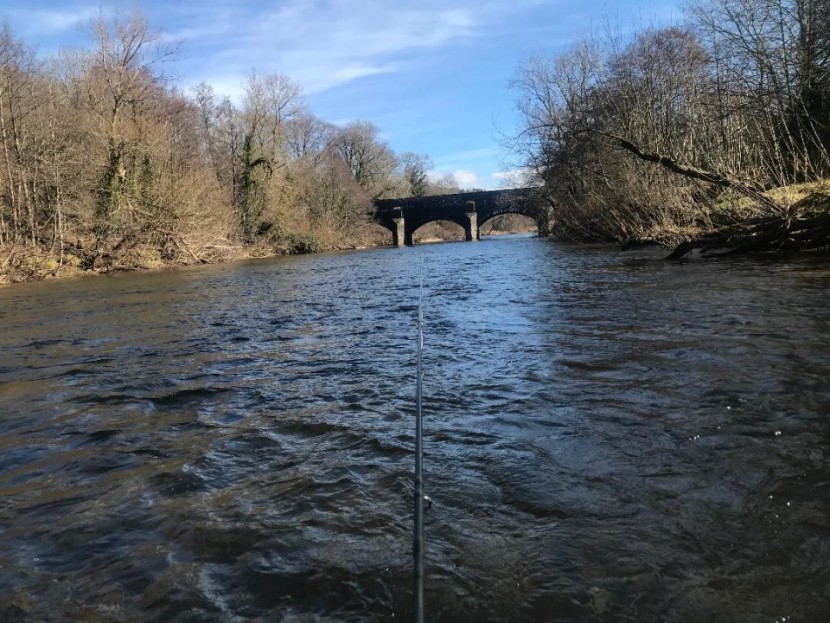 Glanusk Ty Mawr - David Jackson from Halesowen
Glanusk Ty Mawr - David Jackson from Halesowen 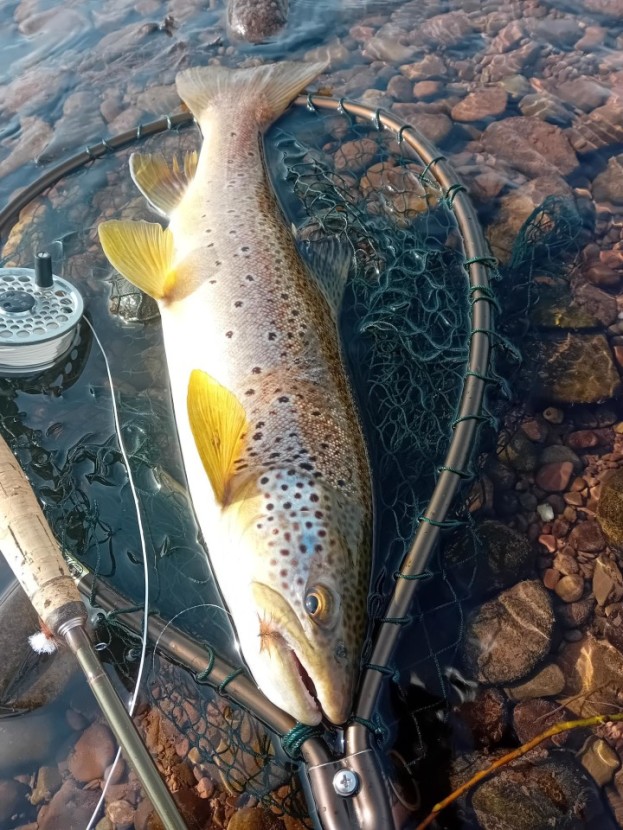 Usk trout - Seth Johnson-Marshall
Usk trout - Seth Johnson-Marshall It was warmer still by the next day and we were reminded again that salmon fishing can be a bit like what we used to say about buses: after a long wait, two or more show up together. Glynn Cawte who was fishing a Flying C at Lower Carrots and Luggsmouth was said to be out of breath when at 13.08 he called in a fresh, sea-liced hen fish of 26 pounds. Fifty minutes later he was on the line again, this time to report another three sea winter fish of 20 pounds. Darrion Eley fished this and the following day on the Dee at Llangollen Maelor, catching 8 trout on heavy nymphs but unfortunately failed to avoid a large number of out of season grayling.
JL from London with a friend accounted for 15 Usk trout at Dinas during a hatch lasting from 11.30 to 12.15. Greg Cann from Pontypridd fished upstream on the Breconshire Fishery and caught 4 trout using March Brown spiders and a Brecon Cob. The last March Brown imitator is as traditional a winged wet fly as you will get on the Usk. In rather similar vein I was intrigued to read a report from Huw Edgar Evans of Swansea, who caught 2 trout on a dry March brown pattern at Glanusk Estate during a 40 minute hatch in the middle of the day. It was the first time he had fished the Usk for 55 years. Seth Johnson-Marshall of Herefordshire had another wonderful day on a private beat of the upper middle Usk. He fished from 11 to 2 while large dark olives and March browns were hatching, and on dry March Brown patterns accounted for four trout, 13 inches, 17 inches, 19.5 inches, and 20 inches. The last fish was weighed at 3 pounds 2 ounces. Another good fish of 18 inches was in a bag of 4 taken by JL from London with a friend at Ashford House, and yet another, not measured, by Tom Lawson of London on a Hare’s Ear nymph at Glan yr Afon.
Adam Price-Huntley from Dudley was fishing for salmon on the Middle Hill Court beat below Ross on Wye when he caught and released a large out of season pike. The Middle and Upper Hill Court beats have a reputation for their coarse fishing, but both used to be available for salmon fishing during the spring at a very reasonable price. Goodrich Court, of course, is the one mainly known for its salmon pools, but 23 pounds will get you onto Middle Hill Court for the tail of the Vanstone, the Rope and Parson’s Tree. Upper Hill Court includes Hom Pil, Hom Stream and Pashley’s Crib, famous pools which I used to enjoy fishing from the Ross Angling Association side of the river, but I think this one remains closed now until the start of the coarse fishing. The Golden Mile produced two springers on the fly during this weekend: a fresh fish of 12 pounds on a Black and Yellow Waddington for David Ranger and a cock fish of 25 pounds on a Black and Yellow tube for Adam Joseph. Ian Gilland from Pontypridd caught 12 trout from the Usk at Dinas and reported a poacher spinning the river above the bridge. We know there is a poaching problem in the Brecon area and I trust this incident was either challenged or reported to the police at the time? If you leave the report till you get home, there is very little chance of anything being done about it. On the 24th Wyesham reported a 12 pounds sea-liced salmon from the lower Wye and on the same day Michel Beach caught a 23 pounds hen fish on a Cascade from Holme Lacy 4. Wyesham responded again the next morning with an 18 pounds sea-liced fish. Joe Alexander from Rhayader described wonderful spring fishing on the Ithon at Llandewi. Large dark olives were hatching most of the day in warm weather and there were a few March browns around lunchtime, although the river was very low and clear. He caught 4 trout on dry flies. I don’t know anybody who enjoys fishing the tributaries as much as Joe does.
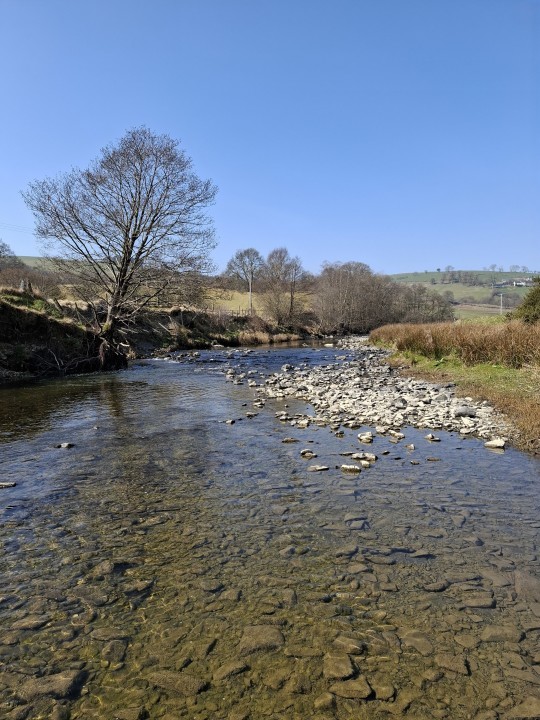 Low water at Llandewi - Joe Alexander
Low water at Llandewi - Joe Alexander  First of the season - AC from Stroud
First of the season - AC from Stroud The 25th continued with some proper warm spring weather. PR from Bristol reported 8 trout to 17 inches from the Glanusk Ty Mawr / Canal and Rivers Trust beat of the Usk below Brecon, although not much was hatching or rising. Greg Boucher of Cheltenham was fishing upstream at Dinas where he lost 8 trout on a barbless size 10 March Brown Jingler in the fast water. Tony Hamilton of Swansea found large dark olives hatching at Gromaine and Upper Llanstephan. He caught a trout but was unable to avoid large numbers of out of season grayling. On the 26th Rick Wells from London reported a 17 inch trout from Buckland taken on a Yellow Wulff during a March brown hatch. Gary Clark from Crediton had 8 trout to 14 inches on a Jingler from the fast water at Dinas, while Alastair Sayell from Newent accounted for half a dozen trout on a CDC March Brown Dun during two short hatches on the Usk Town Water. Gavin Mudge from Hengoed reported 6 trout from the Usk Reservoir.
The final weekend of March was not easy, although I have the impression anglers enjoyed the spring sunshine at least. The days were very bright and the rivers low and clear. FR from Hereford had 4 trout at Ashford House, 2 of them specimens. JT from High Wycombe enjoyed himself despite difficult conditions at Green Bank and caught a brace. Pete Mac of Weobley described watching “a bed of eels” in the Lugg at Eyton. Lampreys getting ready to spawn early, I am wondering?
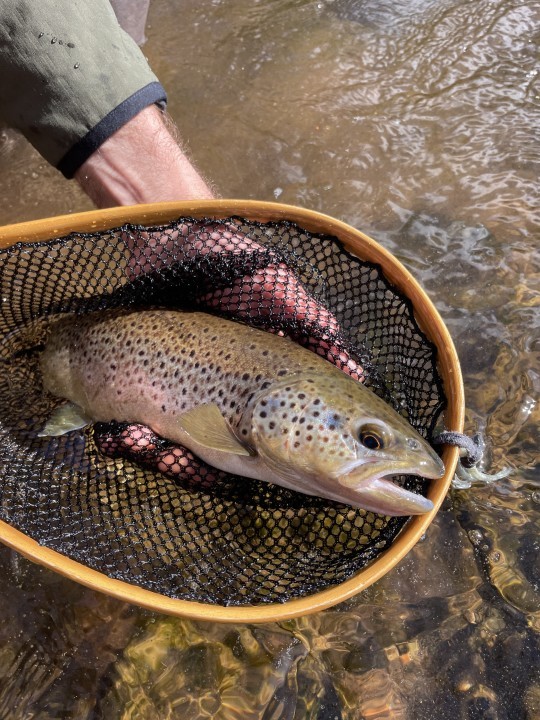 Ashford House trout - FR from Hereford
Ashford House trout - FR from Hereford 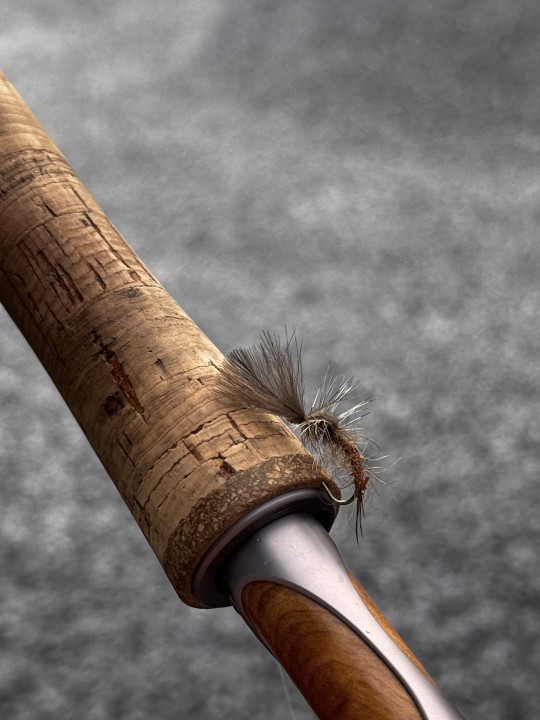 Grunter - Anthony Pease from Llandovery
Grunter - Anthony Pease from Llandovery The folks at Afonydd Cymru were not much impressed with the latest water quality assessment provided by Natural Resources Wales for SACs (Special Areas of Conservation). This survey broadly covers the period 2020-3 and follows a previous survey published in 2021. There are some brighter patches: the lower Wye now passes its phosphate target while there is an improvement in nutrient and other pollution levels on the Usk system so that 54% of it now achieves “good” status compared to 12% in 2021. Why then are fish numbers still dropping? Most of the other Welsh SACs are failing to achieve good status targets. I learned to my surprise that cypermethrin, the sheep dip banned in 2006, is still in use in some situations.
More disappointing news for anglers on the Welsh borders is that, following the recent change of governments, the Sustainable Farming Incentive is definitely to be paused. The Wye and Usk Foundation, concerned that land usage is probably the most important factor affecting our rivers, has been working hard to create partnerships with farmers in the area for the benefit of the environment and 35 million pounds of public money were due to be spent with the aim of improving the Wye and the Usk. As reported in the January letter, and right in the middle of talks with farmers, we learn that existing plans will be suspended, at least for a time. Instead, 1 million pounds from the English and Welsh budgets will be made available this year for yet another study of the Wye’s problems.
Princess Anne was in our bank the other day. Apparently she had asked to visit us, having heard of the damage which winter flooding of the Cannop Brook had done to businesses and homes in our little town. I must say that was very nice and indeed very typical of her. Nerma and I missed her by a few minutes, but the recently departed royal presence had left a quite palpable glow amongst the branch staff. The customers in the bank that day consisted as always of elderly people, usually known as technophobes, who would rather not do all their banking online and who prefer a personal service at a local branch. People like us in fact. Now the flooding Cannop stream which caused all the trouble is back within its banks. The bridge remains damaged, but a single line of vehicles crosses under traffic light control. On the high street itself, some of the shops and businesses as well as the bank have been cleaned out from the mud on ground floors and the sandbags are gone. However, quite a few shops remained boarded up and with sandbags still in place. These are the businesses which failed, the floods having proved to be the final straw.
At least the bank was open again, which had been a matter of some doubt. “We are so pleased you aren’t closing,” most of the customers gushed in relief to the clerks in the branch at some point during their transactions. The clerks had a quick sideways look for the manager who was wandering around with a clip board trying to persuade customers to take an internet course, and then whispered back: “We are pleased too, of course. We were afraid the company would close us, but looks like we are staying on for now.” Then, at the end of the month, something went wrong with an app and just at the time when salaries are received and payments go out, money transfers stopped moving. “See what we mean,” said the elderly technophobe customers almost triumphantly to anybody in the queue who would listen while they waited around to see if their own particular ship had come in or not. “We told you. Computers will always let you down sooner or later.” I had every sympathy with that thought; to the continual exasperation of my children (who of course are not technophobes), I hate it every time a personal service is replaced by something online. Some dictionaries define technophobe as someone with an irrational dislike for modern information technology. Nothing irrational about it in my view. I would rather spend an hour being shelled than spend the same hour trying to break into some recalcitrant website. Really! This time I noticed the manager had taken refuge in her office upstairs.
This is the tale of a town. Orebro is usually described as one of the new designer cities of southern Sweden, but in many ways it’s more of a country town composed of low rise apartment blocks spread widely among parks and open spaces. There are some offices and a few modern factories. The town lies on the main road between Stockholm and Oslo, but it is surrounded by uniform pine forest with occasional lakes. There are no hills. Try to imagine Milton Keynes transplanted into endless miles of dark green trees. There are some excellent sports halls and heated swimming pools. Elks occasionally wander into the outskirts of Orebro and almost everybody hunts. People like to bathe and canoe in the lakes. Other open air sporting possibilities such as cross-country skiing and ice skating are based on the winter months.
My Bosnian brother-in-law Edin and his wife Tanja have now spent more than half their lives in Orebro. Their three sons grew up there and now live and work in Stockholm. Arrival in this particular Swedish town was a matter of pure chance as far as the family were concerned. In the spring of 1993, with two armies fighting inside their home city, UNHCR put Edin and Tanja and their 3 year-old son Pedza on a priority list for evacuation from Croat-controlled West Mostar. As a mixed Muslim/Croat marriage, the family was deemed to be particularly vulnerable. Tanja was then 7 months pregnant with twins. Edin and my father in law had just been released after 12 days imprisonment with other Muslim men in the notorious Helicopter Factory after Adem suffered a heart attack. The UN-organised evacuation eventually led to a town square somewhere in Poland where four coaches were lined up waiting. Depending on the coach allocated, the little family might have gone to Norway, Denmark or Germany, but it turned out they were on the Swedish list. Tired and stressed but thankful at the same time, off they went into the unknown.
The Scandinavian nations during the 90s were particularly admired in Europe for their open refugee and asylum policy. Edin has always told me that the Swedish authorities were generous and fair but also tough in their approach. The new arrivals understood from the beginning that they were now engaged in a contract with the Swedish state. The benefits, particularly the eventual allocation of an apartment in Orebro, were considerable but completely dependent on the efforts of the asylum seekers themselves who were expected to learn Swedish and engage in employment as soon as possible. Those who failed to show up at adult education classes found their support curtailed quite rapidly.
Looking back after more than 30 years, the contract between citizens and state has been a success. Child care to support employment was superb, although, like everything in Sweden, paid for with high taxes. Edin worked for a company which builds giant tunnel-boring machines and retired recently as a team leader. Tanja still works as a food hygienist (for which she was already qualified) in the laboratory of a dairy processing company. The sons are all grown, working in IT and living in their own flats in Stockholm. Pedza the eldest did a master’s degree in Geneva and now works for Apple. His father Edin is sadly suffering from a slow-burning lymphatic cancer which causes him a lot of stress and discomfort, but the Swedish Health Service has been outstanding in the support and treatment given. His oncologist has become an old friend. (And it makes me smile to think that my brother-in-law, who has a nice dry sense of humour, has changed during all the years I have known him from a happy-go-lucky Bosniak, fond of a drink and a song, to a slightly more responsible Swede. He always has his headlamps dipped when he drives out early in the morning and he wouldn’t dream of flushing an apartment toilet after midnight to disturb anybody). Thus a family has progressed in the expected pattern from asylum, to permanent leave to remain, to Swedish citizenship. What you see today is a Swedish family with historic links to southern Europe which are already visibly fading as one generation succeeds another.
Edin tells us that Orebro today is not the same place as when we last visited. The town now has several groups of migrants. Apart from the Bosnian community, mostly from Mostar and Tuzla, there is now a much larger contingent from Somalia. More recently, large numbers from Syria have been arriving. There has always been a certain reticence between citizens of different origins. For example, according to Edin there would be correct and even friendly relations on the factory floor, but Swedes would be reticent about inviting Bosniaks for drinks together after work. Edin and Tanja’s social life, therefore, tends to be with fellow migrants from Bosnia rather than with Swedes. There is virtually no contact between Bosniaks, Somalis and Syrians.
The younger generation of new Swedes including our nephews in cosmopolitan Stockholm seem to have friends from all kinds of backgrounds. But in a smaller community like Orebro, the older generation in the different groups have not succeeded to be comfortable with each other. Unemployment levels amongst the newer arrivals are high and levels of Swedish speaking are lower. Much worse than that, the younger generation of more recent migrants have begun to form gangs which resort to violence during territorial disputes. Shootings and bombings have occurred in quiet places totally unused to such events. There were over 30 bombing incidents across Sweden during January 2025. Swedish citizens have been wondering what happened to the “social contract” model of migration. Understandably an ever louder right wing voice is calling for the pace of immigration into Sweden to be slowed.
On 4th February an event occurred in Orebro which shocked the whole Swedish nation. A lone gunman loaded with weapons and ammunition appeared at the Risbergska campus, an adult education institute, and fired indiscriminately for over an hour at students and staff. This is the place in Orebro where migrants come to learn Swedish and various professional skills; 2,000 adult students are enrolled. According to one account the perpetrator was shouting: “You should go away from Europe” and he was selective about his targets. The resulting chaos involved over 120 police officers while groups of students remained under lock down. More than 50 shots were fired before eventually the perpetrator turned a gun on himself. The police chief subsequently described the scene as “a nightmare.” For a long time, police were very reluctant to release the details of the casualties, but currently we have a figure of 11 killed including the perpetrator, 7 women and 3 men between 28 and 68, plus between 6 and 12 persons injured. The casualties include one Bosnian citizen killed and one injured, both from Tuzla, plus two Syrians, one Afghan, one Eritrean, one Iraqi Kurd and one Somali confirmed dead. The local mosque and church both remained open to offer support to survivors of what has been described as Sweden’s most deadly school shooting event.
The alleged perpetrator, Swedish-born Rickard Anderson, was apparently a 35 year old loner, a former student at the institution who had been refused for military service. According to police he had no known contacts with terrorist or other extremist organisations. He was the legal owner of four fire arms, described as hunting weapons. These included semi-automatic shotguns and a Browning BAR semi-automatic rifle. The BAR is the subject of much debate, particularly in the United States, but it is difficult to understand why such a weapon would be considered suitable for hunting deer, rather than a single shot bolt action rifle. Anderson was able to buy large quantities of ammunition and also smoke grenades shortly before the shooting. Sweden, a nation of keen hunters, will certainly be re-examining its gun laws.
This is undoubtedly a difficult time for Sweden and other European nations. Britain’s Suella Braverman has been criticised over the past year for making several speeches querying the success or otherwise of integration and multi-culturalism as adopted government policy in various European countries. These same countries are simultaneously accepting inward migration in large numbers. Sweden will no doubt be doing its own soul-searching on this subject. In Orebro the evidence about the disaster is pointing to right wing extremism and probably mental health problems. A week later in Munich a young man seriously injured over 20 innocent people and killed a mother and baby by driving a car into a crowd. The perpetrator turned out to be a failed asylum seeker from Afghanistan who had not been deported and who was calling on the name of Allah as he was arrested. A couple of days after that in Villach, Austria, a Syrian asylum-seeker stabbed 5 people and killed a 14 year-old boy. And so on, the shocking effect of such violent events becoming gradually more familiar until it seems almost normal. A few years ago I sat on the jury which tried one Sudanese asylum-seeker accused of stabbing to death another Sudanese asylum-seeker in broad daylight on a crowded street in Gloucester. Both of these young men had been provided with apartments and allowances by the local authorities and had been helped at considerable cost by a British NGO. Every moment of the murderous attack had been recorded on various CCTV cameras, but the motive remained obscure. The case ended abruptly when the accused committed suicide in Bristol prison. Meanwhile the streets of quiet country towns around Europe, even towns such as Swedish Orebro, a place once described even as a little dull, now have an edgy feel to them. There is a new feeling of discomfort and distrust abroad. Ms Braverman may have had a point when she saw troubled times ahead.
But then I think of the Americans, the “great democratic experiment” and a nation clearly built on migration. While working with the US military, it was difficult to avoid being impressed by so many different kinds of people from all over a continent who seemed to have achieved a common ideal. In 1960 the Pulitzer Prize winning novelist John Steinbeck constructed a sort of early recreational vehicle and drove 10,000 miles around the US from his Long Island home in an attempt to re-discover his own people. He set down his experiences in Travels with Charley. Sitting on a ridge above the wide valley of Salinas in California, not far from the ranch where he was born and raised, the land covered in wild blue lupines and looking something like heaven it seemed to him that day, he wrote down the following: “If I were to prepare one immaculately inspected generality it would be this: For all our enormous geographic range, for all our sectionalism, for all of our interwoven breeds drawn from every part of the ethnic world, we are a nation, a new breed. Americans are much more American than they are Northerners, Southerners, Westerners or Easterners. And descendants of English, Irish, Italian, Jewish, German, Polish are essentially American. This is not patriotic whoop-de-do; it is carefully observed fact…And this is the more remarkable because it has happened so quickly.”
Carefully observed fact? Maybe Steinbeck was a bit quick with that idea. A month later in New Orleans he was shocked and disgusted to watch a crowd of thousands screaming obscenities at a little black girl in white socks being led into school between four burly marshalls. More visibly afraid than the little girl was a following white man holding his small son by the hand, willing himself to look straight ahead and the muscles in his throat tightening as they too walked into school. Tensions were high and defending lines of State Police and National Guard fingered their weapons while watching the yelling crowd. The same routine would be followed in the afternoon and during the following days. The hostile crowd was led by so-called “cheer leaders,” middle-aged white women clearly playing up to the TV cameras. In between arrivals and departures from the newly integrated school, the same crowd was not above indulging in a little Jew-baiting when a victim could be found. In the South at the beginning of the sixties, Steinbeck found himself struggling to feel much pride or confidence in his fellow citizens’ tolerance or capacity for integration.
There is every reason to expect some more good trout fishing from the Usk, and the Wye too, along with the tributaries, will warm up as the spring progresses. Salmon may be few and far between but those caught at this time of the year are likely to be magnificent specimens.
Tight lines!
Oliver Burch